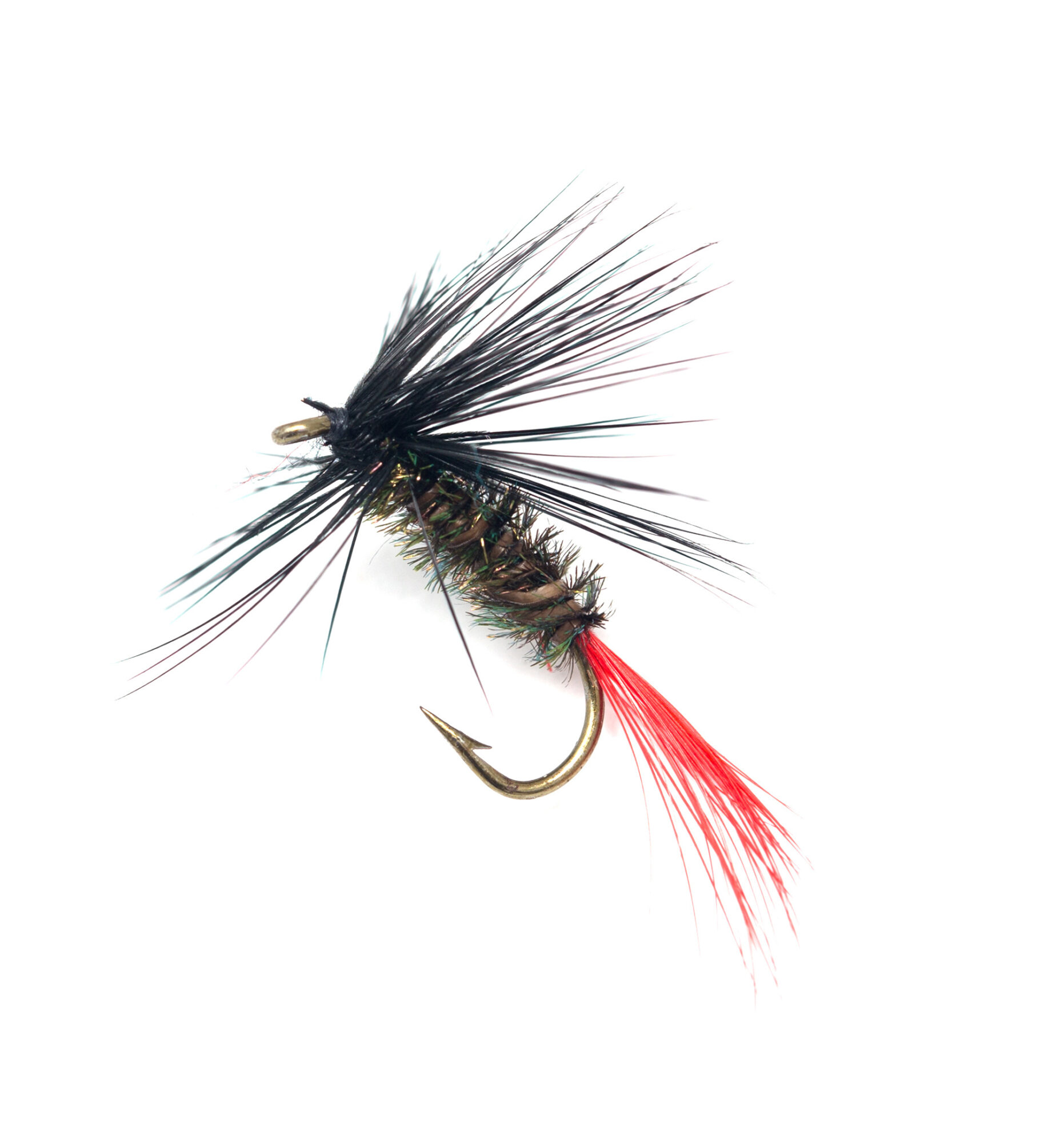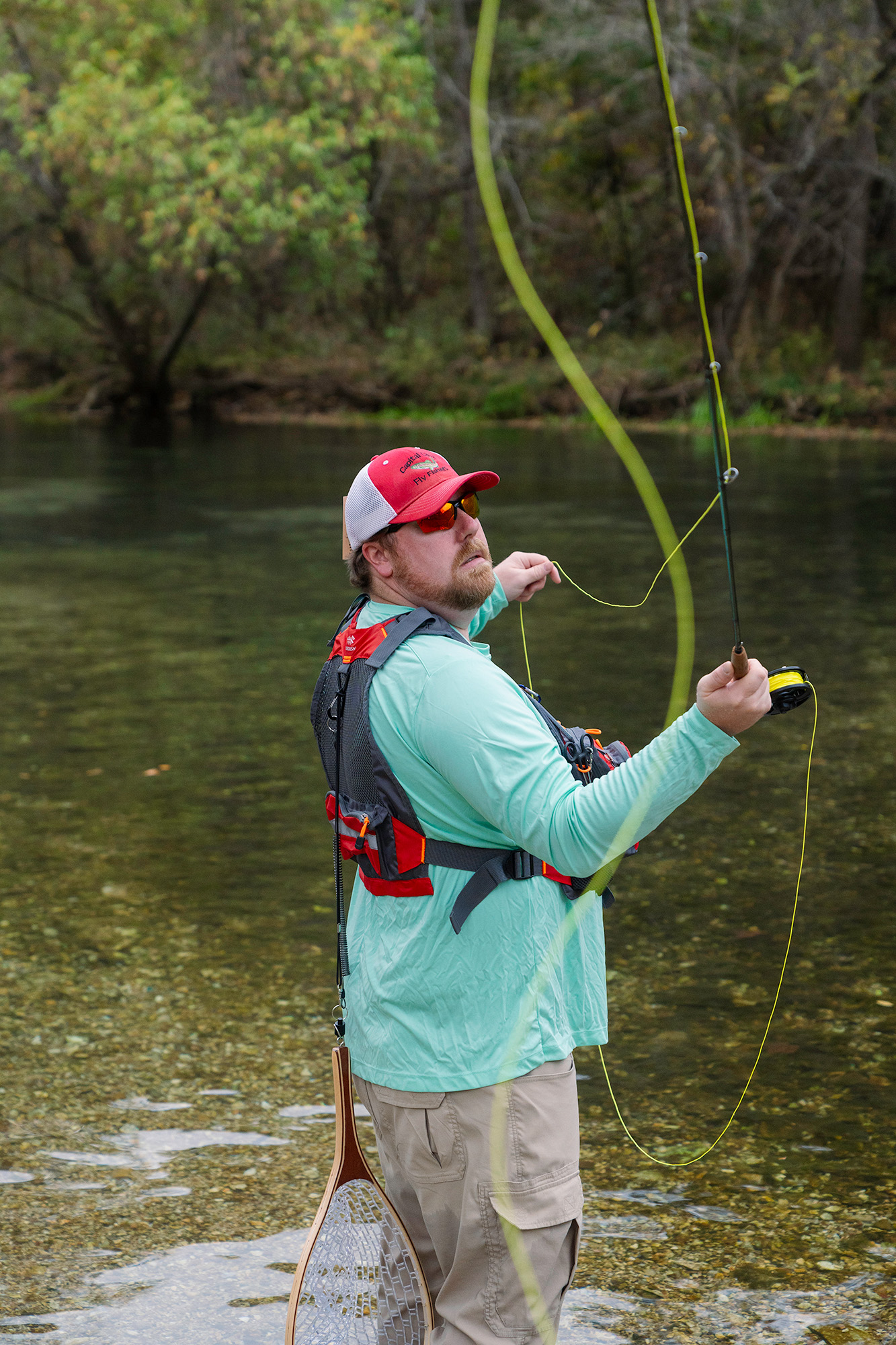Justin Beyer stands at Bennett Spring State Park, ready to make his first cast of the day.
Published by
on

I grew up in mid-Missouri and have always loved fishing. A couple times a year, my dad and I would fish off the dock at a family friends’ house at the Lake of the Ozarks or join my grandpa and fish from his boat in southern Missouri at Otter Slough and Lake Wappapello. But most of my fishing memories are of my dad and me fishing at a neighbor’s pond. My dad would give me advice, and I would learn what fishing techniques worked best for me.
As an adult, I have occasionally taken my wife and met up with friends in Eminence for a float trip down the Current River. On the days we weren’t floating, we’d go over to Montauk State Park, and I’d fish for rainbow trout with my standard rod and reel while she kept me company, occasionally casting a line herself. Every time we would fish, I’d tell her about my dream of upgrading to a fly-fishing kit and learning how to use it.
On Christmas Day 2021, my wife surprised me with an Orvis Clearwater 4-weight rod and reel combo and an assortment of flies. I couldn’t believe it! She had joined a couple of Facebook groups to do research before purchasing anything. This made the gift even more meaningful to me. I immediately jumped headfirst into the world of fly fishing. As a beginner, YouTube turned out to be a major resource as I educated myself.
My next obsession was learning how to tie flies. Once again, my wife was there to help further my newfound interest. In August 2022, she gifted me a fly-tying kit. Along with an instructional book and DVD, the kit included all the materials I’d need to tie six different fly patterns.
Soon after, I found a local fly-fishing organization — the Capital City Fly Fishers — through a recommendation from my brother. I reached out to the organization’s president and started attending meetings, which would alternate between instructional presentations on tying flies and guest lectures on a variety of related topics. The group members were polite and willing to answer any questions someone new, like me, would have. Fast-forward to January 2023 — I became a full member of the group and by November 2023, I was elected vice president of the group.
I still consider myself a newbie in my journey as a fly fisherman, and I cherish the advice I’ve gotten along the way. Below are some tips for building your first kit based on things I wish I knew when I first started:

Get the right kit
Fly fishing is a technique that can be used in any body of water for almost any type of fish. Start by knowing what species you will be fishing for the most and buy a specific fly rod and reel appropriate for those fish. In the world of fly fishing, the rods and reels are categorized by the fishing line’s weight and the rod is paired accordingly.
Fly rods are categorized based on their line weight and are measured in grams from the thinnest and lightest (1 weight), all the way up to the thickest and strongest (15 weight). If you’re fishing primarily for bluegill or trout, a 1- to 3-weight rod would be appropriate. If you’re fishing for trout, smallmouth bass and largemouth bass, then you’ll likely want a 4- to 6-weight rod.
Most Missourians choose a 5-weight rod because
it’ s considered a good, all-around rod that can catch the variety of fish we have throughout the state. If you’re wanting to fish for heavier largemouth bass, steelhead trout, salmon, pike or muskie, you’ll want to go for a 7- to 9-weight rod. Whatever option you choose, I recommend getting a rod and reel combo, where the reel already has line on it and is sold with the rod.

What’s for dinner?
Once you have your rod and reel, you’ ll need some flies. Flies are designed to imitate natural food for fish. When choosing flies, consider how you will present the bait to the fish. You’ll want to choose flies that match your preferred fishing style that also resemble insects near the body of water you’re fishing and what the fish are actively eating. If you’ve ever heard the phrase match the hatch, that’s what it refers to.
Generally, there are three types of flies to choose from:
- Nymph flies imitate larva-stage insects, while streamer flies imitate anything from leeches to small fish. These flies are run under the surface of the water, near the bottom.
- Emerger flies imitate aquatic adult insects rising to the surface or adult insects that got stuck in the water that have sunk below the surface. These flies are usually worked under the water’s surface, but above the bottom of the stream.
- Dry flies imitate adult insects that fly or that rest on the water’s surface.


Pack it up
The next item you need is a vest or pack to carry all your flies and gear. Whether you want a vest with several pockets or a pack that’s positioned on the center of your chest is completely up to you. Just make sure whatever you choose, it’s comfortable, you can wear it for long periods of time, and it doesn’t hinder your movement or affect casting ability.

You’ll also need a net with a cord that can clip to and hang from your vest or pack. If you’re planning to fish for trout, get a net that has rubber netting — cloth netting can injure trout. Even if you’re fishing for species other than trout, a net with rubber netting is always a good option.
Lastly, you’ll want a pair of sunglasses with polarized lenses. Polarized lenses help reduce glare so you can see into the water better to locate fish. More importantly, sunglasses also protect your eyes from a stray hook.
If you’re not sure about spending money on fly-fishing gear without giving the sport a try, there are options to reduce the cost for beginners. All Missouri State Parks trout parks offer rental equipment for anyone who would like to try the sport before they buy gear. If you’d like to try wading into the stream, waders can also be rented at Bennett Spring State Park and Montauk State Park. If you do decide to buy a beginner’s kit, expect to spend around $250 for all the items mentioned.
Don’t forget to purchase the proper permits before you wet your line. You can find information about fishing permits on the Missouri Department of Conservation’s website at mdc.mo.gov/fishing.
As you learn how to fly fish, evaluate equipment, visit different fishing locations and meet other anglers. As you do, you’ll figure out what works best for you and begin to customize your experience. Whether you’re new to fishing or an experienced angler, fly fishing is a fun and unique experience. Whatever your skill level, the most important part is that you’re enjoying the great outdoors. Missouri is full of so many fishing opportunities, I guarantee one of them is right for you.
Looking to fish for trout?
The streams at Bennett Spring, Montauk and Roaring River state parks are stocked every night and offer some of the premier trout fishing in the country. Catch-and-keep trout fishing season opens March 1 and runs until Oct. 31.






